| |
Texan formations provide a nearly unbroken Cretaceous marine fossil record from the Aptian to Maastrichtian.(125-65 mbp). Fossil shark material from Texas has been reported for over 150 years, mostly in obscure papers unavailable to the general public. Welton & Farish (1993) was a landmark publication; it documented the broad scope of these faunas and made it readily available to all. Later in the 90's, Case and Cappetta would build upon the Welton & Farish research and that of Meyers (1974); they brought both a European perspective and propensity to 'split' to the table. The scope of the Texan fauna is too broad for a single webpage, but we hope to provide a snapshot of the latest Maastrichtian deposits.
STRATIGRAPHY AND METHODS
The taxon discussed and illustrated below are (for the most part) from the Kemp Clay of the Navarro Group (East Texas Basin). The Kemp Clay is periodically exposed in a widespread area in Central and North-Central Texas and represents a near-shore environment; Case & Cappetta (1997: 133) suggested estuarine for the specific locale represented in their paper. The accompanying correlation chart attempts to map the upper Late Cretaceous of Texas with those of North Carolina.
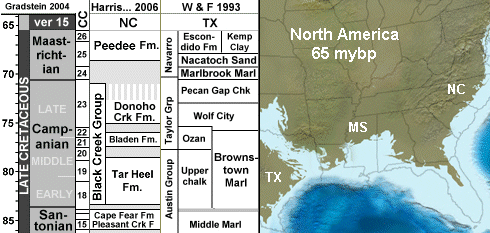 |
| Correlation chart integrated by Jim Bourdon 2008.
Paleomap reproduced with the permission of Dr. Blakey 2007. |
Slumping of the river banks over the past decade has obscured much of this exposure and pinpointing of the precise site of Case's study is not possible. However, scattered sections of this fossiliferous horizon are periodically exposed along the river and have been collected via bulk sampling.
The site1 from which most of the below examples were recovered is located along the banks of the South Sulphur River within the city limits of Commerce, Hunt County, Texas. The exposure at the site was first thought to be from the Early Paleocene, but was later assigned to the Maastrichtian (Stephenson 1941). Sediments were collected in situ and not reduced stream-side. These bulk samples were processed at a later time - all material above 0.5 mm was examined.
FAUNA
The Kemp Clay yields fossils (mostly teeth) of a wide variety of fishes (teleosts & selachians)
and marine reptiles (crocodiles, mosasaurs and turtles)2. The selachian fauna of this site was first fully reported3 by Case & Cappetta (1997) when they documented Case's earlier research and that of the Grants. In that paper they reported 44 taxa, half of which were said to be new. Arguably the claims might be overstated, but the fauna as can be seen below is certainly extensive and many new species (chrono- or otherwise) were represented.
CHONDRICHTHYAN FAUNA
| | | | |
| CLICK ON IMAGES FOR ADDITIONAL DETAILS |
| W&F1993 = Welton & Farish 1993; C&C1997 = Case & Cappetta 1997. |
 — Indicates that the taxon is not currently linked to a 'Genus Page'.
— Indicates that the taxon is not currently linked to a 'Genus Page'.
|
|
|
| HYBODONTIFORMES |
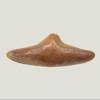 |
Lonchidion cf babulskii ROMER, 1942
Generally scarce to uncommon, these teeth rarely have roots and require careful attention to smaller screened material.
|
| HEXANCHIFORMES |
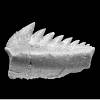 |
Hexanchus cf microdon (AGASSIZ, 1843)
A rare element of most faunas, these teeth are usually represented by fragments only. Cappetta & Case (1997:134) included them as Hexanchus sp and Welton & Farish (1993: 72) as H. microdon. [Thumbnail specimen from the Paleogene of Morocco.] |
| SQUALIFORMES |
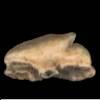 |
Squalus huntenensis CASE & CAPPETTA 1997
Included by Welton & Farish (1993:74) as Squalus sp, C&C1997 erected a new species for this tooth-design. These teeth are scarce in the Kemp Clay. |
| SQUATINFORMES |
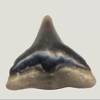 |
cf Squatina "hassei" LERICHE 1929
Case & Cappetta (1997:138, pl 5.3-4) included Cretorectolobus but not Squatina in the fauna; W&F1993:77 included as S. hassei. Specimens studied for the webpage compare much better with Squatina and have been included as such. |
| HETERODONTFORMES |
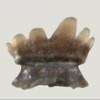 |
Heterodontus "granti" CASE & CAPPETTA 1997
This tooth-design attributed to Heterodontus could be quite unusual if it lacks the expected lateral position crushing teeth. However, these teeth may represent tooth-positions from a juvenile H. rugosus (not contrasted in C&C1997). Scarce. |
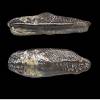 |
Heterodontus cf rugosus AGASSIZ 1839
A tooth-design consistent with adult Heterodontus rugosus teeth from other faunas; Neither W&F1993 not C&C1997 included this species. W&F1993:79 included H. cf canaliculatus (EGERTON in DIXON 1850) in the Campanian of TX. Scarce. |
| ORECTOLOBIFORMES |
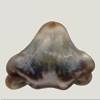 |
Cantioscyllium meyeri CASE & CAPPETTA 1997
C&C1997:137 erected this species for very small Cantioscyllium-like teeth which would suggest they could be an ontogenetic variation of C. decipiens WOODWARD 1889. Found when screening for 1-2mm class specimens - uncommon. |
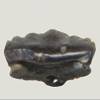 |
Ginglymostoma sp
Cappetta & Case (1997:136) reported a single fragmentary specimen. The accompanying tooth appears to correspond with their depicted specimen (pl 6.4) which lacks labial ornamentation. W&F1993:83 included G. lehneri LERICHE 1938 (moved to Plicatoscyllium). |
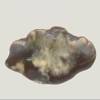 |
Nebrius sp
Cappetta & Case (1997:136) reported a single damaged specimen which does appear to represent Nebrius. The accompanying image represents a well-worn specimen that may also represent this scarce taxon. |
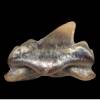 |
Plicatoscyllium "derameei" CASE & CAPPETTA 1997
An uncommon tooth in the Kemp Clay, C&C1997:137 included Welton & Farish's (1993:83) Ginglymostoma lehneri LERICHE, 1938 in this new taxon. After several readings, it is difficult to understand why P. minutum (FORIR, 1887) was not used for these teeth. |
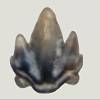 |
Plicatoscyllium "antiquum" CASE & CAPPETTA 1997
A small and scarce tooth-design of the Kemp Clay. Case & Cappetta (1997:137) found it necessary to erect another taxon for what are most likely an ontogenetic variation of the above taxon; both of which likely represent P. minutum. |
|
Cretorectolobus cf olsoni CASE 1978
This tooth-design, uncommon in the fauna, was attributed to Cretorectolobus by Case & Cappetta (1997: 138, pl 5.3, 4). These teeth compare better with Squatina teeth from North America and have been included above as such. |
| LAMNIFORMES |
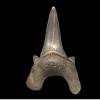 |
Archaeolamna kopingensis (DAVIS, 1890)
Not reported by Welton & Farish or Case & Cappeta, these teeth, more common in higher latitudes, are present but uncommon in the Kemp Clay. |
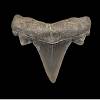 |
Cretalamna maroccana ARAMBOURG, 1935
Often refered to as biauriculata VON ZITTEL, in Wanner, 1902 (as an ontogenetic variation) and reported by Welton & Farish (1993:112. fig. 6 only) as Serratolamna serrata (AGASSIZ, 1843), these teeth are uncommon in the Kemp Clay. |
|
|
Cretalamna sp of Case & Cappetta (1997)
A single appendiculata-like lateral was reported by Case & Cappetta (1997:139) as Cretalamna sp;
Welton & Farish (1993:103) included appendiculata as present in Maastrictian deposits. No additional representative example could be located. |
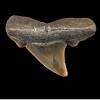 |
Serratolamna serrata (AGASSIZ, 1843)
The lateral teeth with their asymmetrical crowns are quite recognizable and common in the Kemp Clay.. Reported by both W&F1993 and C&C1997. |
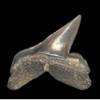 |
Pseudocorax granti CAPPETTA & CASE 1975
W&F1993:123 and C&C1997:139 reported P. granti; however only the latter included these teeth in the Maastrichtian.
Common in the Kemp Clay, Hamm & Shimada (2007) argue that these teeth should be attributed to P. laevis (LERICHE 1906). |
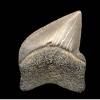 |
Squalicorax cf lindstromi (DAVIS, 1890)
Uncommon to scarce in the Kemp Clay, much more abundant in Campanian sediments. Included by C&C1997:140 but limited to the Campanian by W&F1993:118). Formerly referred to as S. "kaupi". |
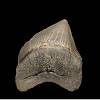 |
Squalicorax pristodontus (AGASSIZ, 1843)
These large crow shark teeth, reported by both W&F1993:119 and C&C1997:140, are common in the Kemp Clay. |
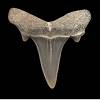 |
Carcharias heathi CASE & CAPPETTA 1997
C&C1997:140 erected this species for a smooth-crowned sandtiger tooth-design common in the Kemp Clay; these teeth were refered to as Carcharias sp B in Welton & Farish (1993:92, fig 3 only). |
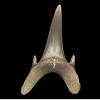 |
Eostriatolamia holmdelensis (CAPPETTA & CASE 1975)
Case and Cappetta (1997:141) reported this taxon based on a six teeth. The striated lingual crown face is one useful diagnostic characteristic. |
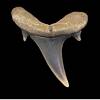 |
Carcharias cf samhammeri CAPPETTA & CASE 1975
Case and Cappetta (1997:141) reported this smooth-crowned taxon based on a single tooth; they might be deemed relatively uncommon. |
|
|
Carcharias sp 1 of Case & Cappetta (1997)
Case and Cappetta (1991:141, pl 7.2 reported this tooth-design based on a single C. samhammeri-like tooth with lingual folds. |
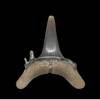 |
Odontaspis aculeatus (CAPPETTA & CASE, 1975)
Case and Cappetta (1997:141) reported this taxon based on a single incomplete tooth. Although damaged, the accompanying specimen is clearly Odontaspis in design - scarce. |
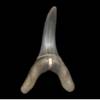 |
Scapanorhynchus cf texanus (ROEMER, 1849)
Case and Cappetta (1997:142) reported Scapanorhynchus-like teeth (mostly incomplete) that did not compare well, in their opinion, with S. texanus . W&F1993:95 included these teeth as texanus and the accompanying tooth compares well with a S. texanus LA2. |
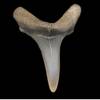 |
Anomotodon toddi CASE & CAPPETTA 1997
Erected for smooth crowned Anomotodon-like teeth from the Late Maastrichtian and included Taylor Group (Campanian) specimens presented in Welton & Farish (1993:114, fig 2-5) as Paranomotodon. |
| CARCHARHINIFORMES |
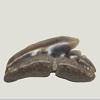 |
Galeorhinus aff girardoti HERMAN, 1977
Uncommon in the Kemp Clay; Case & Cappetta (1997:143) attributed most of the Welton & Farish (1993: 127, fig 1,3-5) Galeorhinus sp specimens to this species. |
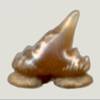 |
Palaeogaleus navarroensis CASE & CAPPETTA, 1997
Relatively common in the Kemp Clay; Case & Cappetta (1997:143) attributed the Welton & Farish (1993: 128) Palaeogaleus sp teeth to this newly erected species. |
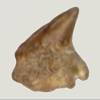 |
Squatigaleus sulphurensis CASE & CAPPETTA, 1997
C&C1997:144 described these small, high root, low-crowned teeth noting the similarity with teeth from North Africa. Possibly due to their size (1.5 mm class), these teeth are scarce to rare in the Kemp Clay. |
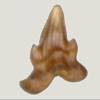 |
Scyliorhinus ivagrantae CASE & CAPPETTA, 1997
Erected for small 1.5 mm class catshark tooth; uncommon when screening for smaller items. C&C1997:144 included the Scyliorhinus sp teeth of Meyer (1974) and McLellan (1988) in this species. |
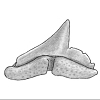 |
Undetermined carcharhiniform of Case & Cappetta (1997)
Case & Cappetta (1997: 144) include a single example of a triakid / carcharhinid tooth of undertermined origin; the accompanying image was drawn from their paper. |
| RAJIFORMES |
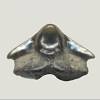 |
Ischyrhiza mira LEIDY, 1856
Teeth and rostral denticles deemed common by Welton & Farish (1993: 141); Case & Cappetta (1997:148) reported only rostral denticles. |
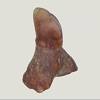 |
Ischyrhiza avonicola ESTES, 1964
Deemed generally common by Welton & Farish (1993: 140), these teeth and rostral denticles were not included by Case & Cappetta (1997:148); they included small rostral denticles as I. monasterica (below). Also see: rostral denticles. |
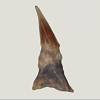 |
Ischyrhiza monasterica CASE & CAPPETTA, 1997
Case & Cappetta (1997: 148) erected this taxon for I. avonicola-like rostral denticles which they found to be more gracile in design. Also see: rostral denticles. |
|
Schizorhiza cf weileri SERRA, 1933
A singular rostral denticle was included by Welton & Farish (1993:145) as from the Escondido Fm. of Maverick Co., TX. No specimens were available to include. |
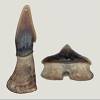 |
Sclerorhynchus pettersi CASE & CAPPETTA, 1997
C&C1997:148 deemed the rostral teeth somewhat scarce & oral teeth very scarce. The rostrals are distinguished by their barbed posterior edge and the small oral teeth by their high root. Welton & Farish (1993:145) included no Maastrichtian examples. |
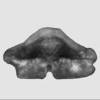 |
Ptychotrygon vermiculata CAPPETTA, 1975 aka P. triangularis (REUSS 1844).
Likely a chrono-species of P. triangularis , Case & Cappetta (1997: 150) found them to be common in the Kemp Clay and included Welton & Farish's (1993:150) P. texana examples in this species. The accompanying image is of a Campanian example. |
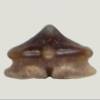 |
Ptychotrygon winni CASE & CAPPETTA, 1997
This taxon was erected for a much less common, high-cusped Ptychotrygon tooth-design. Welton & Farish's (1993:150, fig 1 only) illustration of P. texana may better be ascribed to P. winni than P. vermiculata. |
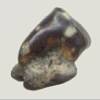 |
Rhinobatos uvulatus CASE & CAPPETTA, 1997
An uncommon guitarfish from the Kemp Clay, this tooth-design was referred to by Welton & Farish (1993: 131) as R. casieri HERMAN in CAPPETTA & CASE 1975. |
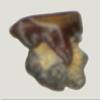 |
Rhinobatos craddocki CASE & CAPPETTA, 1997
A small (1 - 1.5mm class) scarce tooth from the Kemp Clay; weak to moderate uvula. |
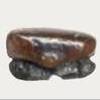 |
Protoplatyrhina renae CASE 1978
Case & Cappetta (1997:147) reported several specimens from the Kemp Clay, Welton & Farish (1993: 133) deemed them common. |
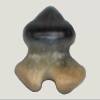 |
Raja farashi CASE & CAPPETTA, 1997
A small but common component of the Kemp Clay; this tooth design was included by Welton & Farish (1993: 137) as 'Rajidae -- genus and species undetermined'. |
|
Hamrabatis weltoni CASE & CAPPETTA, 1997
Case & Cappetta (1997:151. pl 14.5-6) erected this species for a tooth-design which they deemed rajiform based on more clearly defined material (but different root-design) from Egypt. A similar tooth is included as Dasyatis sp below. |
| Incertae cedis |
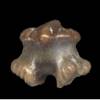 |
Ewingia problematica CASE & CAPPETTA, 1997
Undoubtedly the most bizarre and often beautiful specimen from the fauna (is it tooth or denticle?). Cappetta & Case (1997: 154) deemed it Batomorphii incert. fam. -- a wisely ambiguous position. |
| MYLIOBATIFORMES |
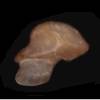 |
Dasyatis commercensis CASE & CAPPETTA, 1997
Relatively common in the Kemp Clay, Case & Cappetta (1997:152) noted that sexual dimorphism is present in this tooth-design. Welton & Farish (1993: 156) included various tooth-designs as Dasyatis spp. |
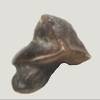 |
Dasyatis sp
Somewhat common in the Kemp Clay, Case & Cappetta (1997:151. pl 14.5-6) erected
Hamrabatis weltoni (as a Rajiform) for similar teeth; they noted that McClellan (1988) had deemed them ?Dasyatis sp. This tooth-design may be a male (cuspidate) version of Dasyatis commercensis. |
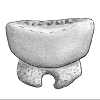 |
Coupatezia turneri CASE & CAPPETTA, 1997
Reported by Case & Cappetta (1997: 152, pl 12.7) on the basis of a single Coupatezia-like tooth from the Kemp Clay. Comparable examples could not be found suggesting availability is Scarce to Rare. |
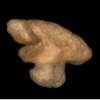 |
Texabatis corrugata CASE & CAPPETTA, 1997
Based on some twenty specimens, Case & Cappetta (1997: 153) erected this taxon for dasyatid-like teeth displaying little sexual dimorphism from the Kemp Clay -- family uncertain; also see W&F1993:156 Fig 1. [Erect labio-lingually compressed roots suggest mobulid.] |
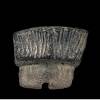 |
Rhombodus binkhorsti DAMES, 1881
As with most NA Maastrichtian faunas, this taxon represents a common component of the Kemp Clay. See W&F1993:155 and/or C&C1997:153. |
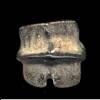 |
Rhombodus sp
Case & Cappetta (1997: 154) included a tooth-design which varied from R. binkhorsti but was otherwise similar to that taxon. Based on their five specimens, this design should be deemed scarce to uncommon. |
AKNOWLEDGEMENTS
We'd like to thank Mikael Siverson for his time and attention to the Squatina vs Cretorectolobus issue and Pieter DeSchutter for tracking down some needed European literature.
FOOTNOTES
| 1 | Refer to Case & Cappetta (1997) for details. |
| 2 | A single eutherian premolar was reported by Tokaryk (1987). |
| 3 | In his doctoral dissertation, Meyer (1974) extensively sampled and reported on the Late Cretaceous of Texas; lacking a copy of that manuscript, it is possible this locale was covered at that time. Welton & Farish (1993) provided no detailed locale information for their Kemp Clay material. |
REFERENCES
Cappetta, H. and Case, G., 1975. Sélachians nouveaux du Crétacé du Texas. Geobios 8: 303-307.
Cappetta, H. and Case, G., 1999. Additions aux faunes de sélaciens du Crétacé du Texas (Albien supérieur-Campanien). Palaeoichthyologica, 9, 5-111.
Case, G. and Cappetta, H.. 1997. A new selachian fauna from the late Maastrichtian of Texas. Münchener Geowissenschaften Abhandungen 34:131-189.
Gradstein, F., Ogg, J. & Smith, A., 2004, A Geological Time Scale 2004. Cambridge University Press. 589pp.
Hamm, S. and Shimada, K., 2007. The Late Cretaceous anacoracid shark, Pseudocorax laevis (Leriche), from the Niobrara Chalk of western Kansas. Transactions o the Kan Acad Sci, vol. 110, no 1/2, pp 44-52.
Harris, W. and Self-Trail, J., 2006. Late Cretaceous base level lowering in Campanian and Maastrichtian depositional sequences, Kure Beach, North Carolina. Stratigraphy, vol. 3.3, pp. 195-216.
McLellan, J., 1988. Notes on fossil shark teeth from the Escondido Formation of Texas. Unpubl. Report p 1-21.
Meyer, R., 1974. Late Cretaceous elasmobranchs from the Mississippi and East Texas embayments of the Gulf Coastal Plain. Unpubl. PhD dissertation, Southern Methodist Univ., Dallas, xiv+419 p.
Stephenson, L., 1941. The larger invertebrate fossils of the Navarro Group of Texas. Univ. Tex. Publ., 4101: 27-30.
Tokaryk, T., 1987. An Eutherian from the Late Cretaceous (Maestrichtian, Kemp Clay Formation) of Texas. Occasional Short Notes, Saskatchewan Museum of Natural History. 2:1-6.
Weems, R., Self-Trail, J. & Edwards, L., 2004, Supergroup Stratigraphy of the Atlantic and Gulf Coastal Plains (Middle? Jurassic through Holocene, Eastern North America). Southeastern Geology 4:2, USGS pp191-216.
Welton, B. and Farish, R., 1993. The Collector's Guide to Fossil Sharks and Rays from the Cretaceous of Texas. Before Time, Texas. 204 pp.
|